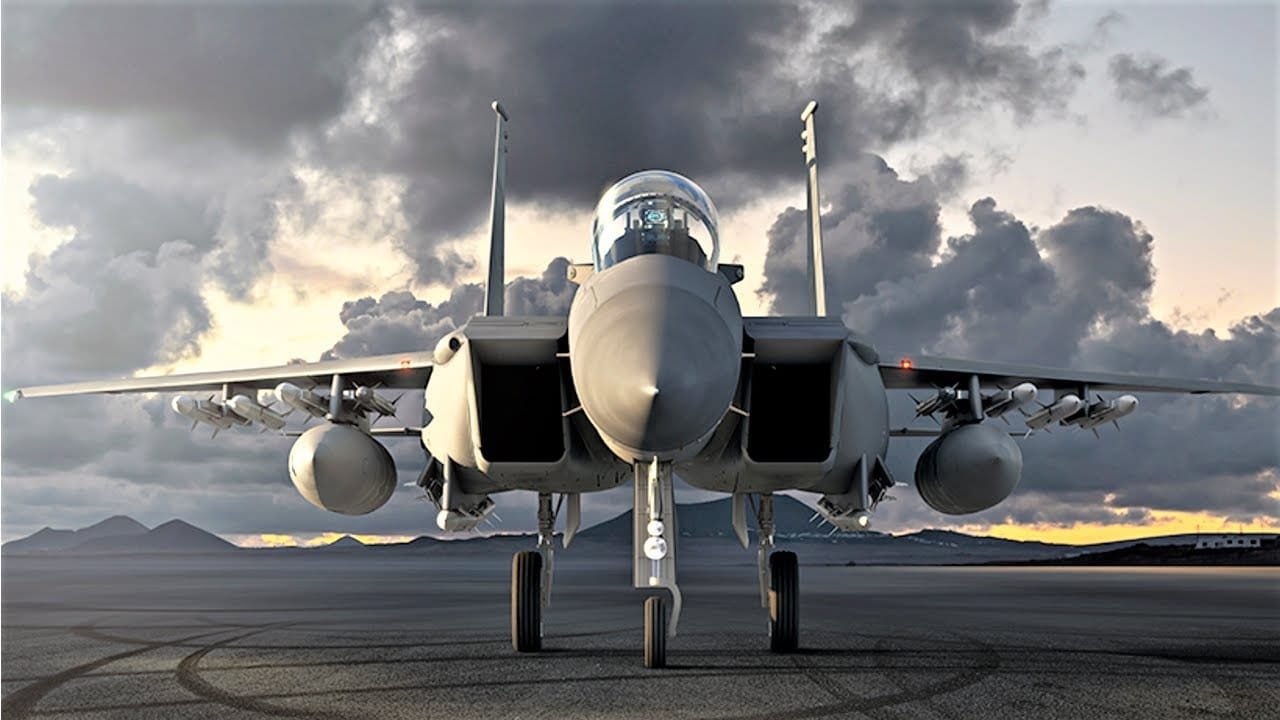This is not the first time the 19FortyFive has written about the latest and greatest edition of the venerable — and still undefeated in air-to-air combat — F-15 Eagle, that being the F-15EX Eagle II. The notion behind the EX variant of the Eagle is that its latest improvements would enable it to serve as a temporary stopgap measure to address both (1) the premature killing of the Lockheed Martin F-22 Raptor back in 2009 by then-SECDEF Bob Gates and (2) the seemingly interminable teething issues of the F-35 Lightning II.
As noted four years ago by Business Insider columnist Oriana Pawlyl, “The strategy would mimic what Boeing did with its Block III F/A-18 Super Hornet: taking an old concept, but boosting the jet fleets to be more potent in current and future missions with a larger variety of weapons, extended range, advanced targeting and sensor systems, and better fuel efficiency, among other enhancements.”
The Eagle II is still not a fifth-generation fighter as it does not have stealth technology, though these upgrades presumably make it a 4.5-Generation fighter like the Indian Tejas (only the Tejas is more compact, of course). There have been a few recent developments, both positive and negative alike, to affect the viability of the F-15EX program. Let’s take a look.
The Good Signs
The most recent positive sign for the Eagle II program was an announcement on Wednesday by the Polish Defense Ministry that the American plane is under serious consideration for the Polish Air Force’s modernization program. Though the South Korean KAI FA-50 “Golden Eagle” (황금 독수리 / hwang-geum dogsuli) is the current frontrunner, Poland’s Minister of National Defence, Mariusz Błaszczak provided this additional nugget of insight: “I will add that the acquisition of those aircraft is not our last move, in the expansion of the capabilities of the Polish Air Force. We have accelerated the delivery of the F-35s. Overall, we are planning to procure extra F-35s or F-15s, and we are watching closely the progress made by our South Korean partners when working on the KF-21 Boramae.”
Given Poland’s ever-increasing importance as a NATO ally in the light of the current situation in Ukraine and the deterioration of Russo-NATO relations in general and Russo-U.S. relations in particular, this is definitely a strong potential lifeline for Eagle II sales prospects. Meanwhile, on the other side of the globe, back in February, Indonesia received the green light from the U.S. State Department to purchase up to 36 F-15EXs to the tune of 13.9B USD, which would make Indonesia the first foreign customer of the Eagle II variant.
And within our own Air Force, Pacific Air Forces (PACAF) commander Gen. Kenneth S. Wilsbach has publicly clamored for the F-15EX for Indo-Pacific ops: “What we intend to use it for there, if we’re so fortunate to get that replacement, is air superiority and some long-range weapons capabilities that you can conduct on the F-15EX.” To that effect, USAF Air Combat Combat published some new photos earlier this month depicting Eagle IIs being flown out of Eglin AFB, Florida by pilots from the 40th Flight Test Squadron and 85th Test and Evaluation Squadron.
Meanwhile, last week Boeing announced in a press release that its Eagle Passive Active Warning and Survivability System (EPAWSS) modification is proceeding as planned. That same press release hastened to add that “In May 2021, the first two F-15EX aircraft, delivered ahead of schedule, participated in Northern Edge exercises with the EPAWSS suite. During the highly contested and complex exercises, the two jets demonstrated operational potential, which set the stage for future incremental improvements, allowing the jets to exhibit proven, outstanding performance in subsequent exercises and flight test missions in October 2021 and February 2022.”
The Bad and the Ugly Signs
All is not smooth sailing for the F-15EX program, however. Back in May, Air Force’s J-books revealed that the service plans to reduce the overall buy of the EX from 144 to 80 — a 44 percent cut. As if that weren’t bad enough, there’s another looming specter that all of us can relate to, which is inflation.
Breaking Defense Senior Reporter Valerie Insinna elaborates: “Boeing intends to keep its next two lots of F-15EXs at or below the company’s original $80 million per unit price point despite inflationary pressures that are raising supply costs, the company’s vice president for fighters and bombers said today…Despite [Boeing’s Steve[]Parker declaring that a contract for F-15EX lots 2 and 3 could be signed in the coming months, Boeing and the US Air Force have had difficulties in finalizing the initial F-15EX contract agreed to in 2020, which remains undefinitized. This has caused some angst amongst lawmakers, most strongly in the House Appropriations Committee, which proposed cutting six of the 24 jets the Air Force plans to buy in its fiscal 2023 defense spending proposal.“
Given the current monetary nightmares of the F-35 — along with those of the B-2 Spirit Stealth Bomber back in the day — such antsy sentiments are entirely understandable. Time will tell.
Christian D. Orr is a former Air Force officer, Federal law enforcement officer, and private military contractor (with assignments worked in Iraq, the United Arab Emirates, Kosovo, Japan, Germany, and the Pentagon). Chris holds a B.A. in International Relations from the University of Southern California (USC) and an M.A. in Intelligence Studies (concentration in Terrorism Studies) from American Military University (AMU). He has also been published in The Daily Torch and The Journal of Intelligence and Cyber Security. Last but not least, he is a Companion of the Order of the Naval Order of the United States (NOUS).

